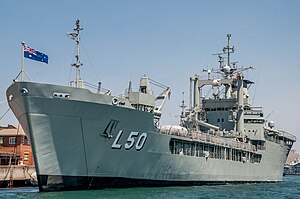ex HMAS Tobruk (L 50)
 |
|
| History | |
|---|---|
| Namesake: | The Siege of Tobruk |
| Ordered: | 3 November 1977 (construction contract signed) |
| Builder: | Carrington Slipways, Tomago |
| Cost: | $59 million |
| Laid down: | 7 February 1978 |
| Launched: | 1 March 1980 |
| Commissioned: | 23 April 1981 |
| Decommissioned: | 31 July 2015 |
| Motto: | "Faithful and Strong" |
| Honours and awards: |
|
| Status: | Sunk as a Dive Wreck in 2018 off Hervey Bay, Queensland |
| Badge: |  |
| General characteristics | |
| Class and type: | Modified Round table Class Landing Ship Heavy |
| Displacement: |
|
| Length: | 127 m (417 ft) |
| Beam: | 18.3 m (60 ft) |
| Draught: | 4.9 m (16 ft) |
| Propulsion: | 2 × Mirrless Blackstone KDMR8 diesel engines, 9,600 horsepower (7,200 kW), 2 shafts |
| Speed: | 18 knots (33 km/h; 21 mph) |
| Range: | 8,000 nautical miles (15,000 km; 9,200 mi) at 15 knots (28 km/h; 17 mph) |
| Boats & landing craft carried: |
2 × LCM-8, 2 × LCVP, 2 x NLE pontoons |
| Capacity: |
|
| Complement: | 148, including 13 officers (as of 2012) |
| Sensors and processing systems: |
|
| Armament: | |
| Aviation facilities: |
|
HMAS Tobruk (L 50) was a Landing Ship Heavy (LSH) of the Royal Australian Navy (RAN), based on the design of the Round Table-class of the British Royal Fleet Auxiliary. Planning for the ship began in the 1970s to provide the Australian Army with a permanent sealift capability. She was laid down by Carrington Slipways in 1979, launched in 1980, and commissioned in 1981. She was a multi-purpose, roll-on/roll-off heavy lift ship capable of transporting soldiers, APCs, and tanks, and delivering them to shore via landing craft or directly by beaching.
The ship experienced problems during her early career with her engines (which differed from the British base design) and sewerage system (leading to the death of a cadet in 1981). During the 1980s, the ship delivered supplies to the Multinational Force and Observers on the Sinai Peninsula, assisted in the withdrawal from RAAF Base Butterworth, provided support and accommodation for delegates to the South Pacific Forum, and was part of the Australian response to the 1987 Fijian coups d'état. In the early 1990s, Tobruk was part of ceremonies marking the 75th anniversary of the landing at Anzac Cove, then after a refit, participated in peacekeeping efforts in Somalia.
Plans to replace Tobruk with one of the Kanimbla-class ships began in 1993. She was offered for sale to the Royal New Zealand Navy, who refused because of the ship's manpower requirements. Delays in converting the Kanimbla's for service meant Tobruk continued with normal operations during the 1990s. Attempts to sell the ship to the British and the Portuguese did not succeed, and in 1997 the decision was made to keep Tobruk, as the Kanimbla's could not completely replace the heavy lift capability provided. During this period, Tobruk was deployed to Bougainville on several occasions as peacekeeping operations during the Bougainville Civil War. At the end of the decade, Tobruk operated as part of the INTERFET peacekeeping operation in East Timor.
In 2000 and 2001, Tobruk was sent to the Solomon Islands on several deployments in response to the civil war: first to evacuate Australian citizens, then as a neutral venue for peace talks. From late 2001 to early 2002, the ship was in northern Australian waters on border-protection duties as part of Operation Relex. During 2005 and early 2006, Tobruk sailed to the Middle East on several occasions to deliver vehicles and cargo to Australian forces in the region. Tobruk and the two Kanimbla's were set to East Timor in mid-2006 in response to the 2006 East Timorese crisis, forming the first RAN amphibious readiness group since World War II. The rest of the decade included further border protection deployments under Operation Resolute, a visit to Hawaii for the RIMPAC multinational naval exercise, support for the Army Aboriginal Community Assistance Program, relief operations following the 2009 Samoa earthquake and tsunami, and use as the venue for a Fall Out Boy concert.
After spending several months in 2010 undergoing extended maintenance, Tobruk participated in the United States Navy's Pacific Partnership humanitarian assistance deployment. Because of the need for propeller shaft repairs, Tobruk could not be part of the military response to Cyclone Yasi. Heavy use and lack of maintenance in previous years began to take its toll, with Tobruk unavailable for service on several occasions during the early 2010s. As the two Kanimbla's had been forced out of service by ongoing issues, the Australian government had to charter a succession of civilian ships to provide standby heavy transport capability. In 2013, Tobruk again participated in Pacific Partnership, followed by a visit to the Philippines with disaster relief supplies after Typhoon Haiyan. In early 2015, the ship was part of the response to Cyclone Pam's impact on Vanuatu. Tobruk was decommissioned in July 2015, and was scuttled as a dive wreck in June 2018.





